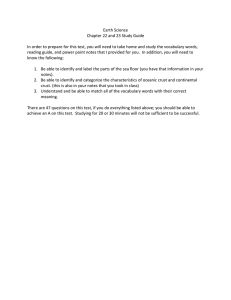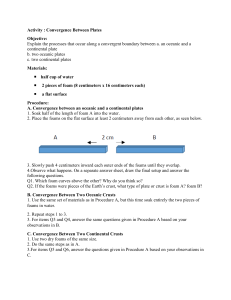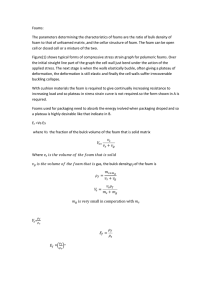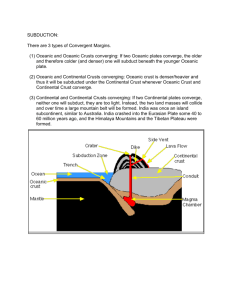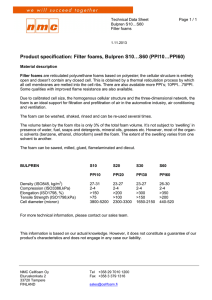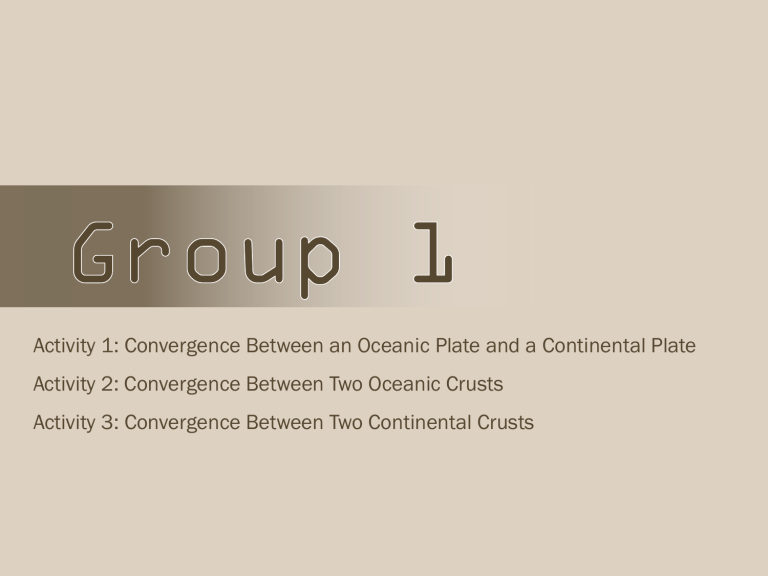
Activity 1: Convergence Between an Oceanic Plate and a Continental Plate Activity 2: Convergence Between Two Oceanic Crusts Activity 3: Convergence Between Two Continental Crusts Convergence Between an Oceanic Plate and a Continental Plate Continental Crust (Dry Foam) Oceanic Crust (Wet Foam) E xplain the processes that occur along a convergent boundary between an oceanic and a continental plate. 1. Half a cup of water 2. 2 pieces of foam (8cm x 16cm) 3. A flat surface 1. Soak half of the length of one of the foams into the water. 2. Place it on the flat surface at least 2cm away from the other foam. 3. Position the soaked part of one of the foams at the middle part of the setup. 4. Slowly push 4cm inward each outer ends of the foams until they overlap. 5. Observe what happens. Q1. Which foam curves above the other? The foam that wasn’t soaked in the water Q2. How does the water in the wet foam affect its density? The water increases the density of the foam Q3. If the foams were pieces of the Earth’s crust, which one is the continental crust? The dry foam is the continental crust Q4. Which foam is the oceanic crust? The wet foam is the oceanic crust Q5. In the activity, what made the wet foam move under the dry foam? The density of the wet foam made it move under the dry foam. Convergence Between Two Oceanic Crusts E xplain the processes that occur along a convergent boundary between 2 oceanic plates. Rectangular basin or food 1. tray half-filled with water 2. 2 pieces of Foam (8cm x 16cm each) 3. A flat surface 1. Submerge the two foams into the basin containing water. 2. Arrange them at least 2 cm away from each other. 3. Slowly push 4cm inward each outer end of the foams. 4. Observe what happens. Q6. In the activity, you should have noticed that one foam moved on top of the other while they are converging. If in the process, the top foam suddenly flips up so that some water is pushed forward and up, what do you see on the water surface, a tsunami or a ripple? If the top foam suddenly flips up so that water is pushed forwards and up a tsunami is seen on the surface. Q7. If the foams were Earth’s plates, then they are oceanic crusts where one subducts under the other. Explain what happens next when there is subduction. When there is subduction, the front part of the subducting plate becomes magma upon reaching the mantle which then builds up pressure due to heat, pushes the crust above it forming a volcano. Convergence Between Two Continental Crusts Continental Crust Continental Crust E xplain the processes that occur when two continental crusts converge. A small soup bowl half-filled 1. with water 2 whole pieces of any 2. crunchy cracker or 2 slices of bread 3. A flat surface 1. Soak at least 1/3 of the part of the two crackers or bread into the saucer containing water. 2. Arrange them on the flat surface so that their soaked parts touch each other. 3. Push the two crackers or bread slices inward and watch what happens. 4. On another sheet of paper, draw what you see in the setup after step 3 and write your answers to the questions that follow. Q8. What happened to the colliding parts of the crackers? The plates (bread slices) tried going over each other and caused a stacking effect which elevated the ends of the bread which collided. Q9. If the crackers were Earth’s crusts, what landform was produced? Because of the ends elevating it caused the formation of really tall geologic features, namely mountain/s and specifically mountain ranges. Q10 . What event will the people residing in nearby places experience? Why? People residing nearby where this phenomena might occur will experience shallow earthquakes due to the collision of plates, which have a tendency to be more destructive than your usual earthquake. Q11 . Do you think volcanic eruption is possible to happen? Why? No, the continental crusts will simply collide and smash against each other, going upwards. Therefore no occurrences involving the mantle.
